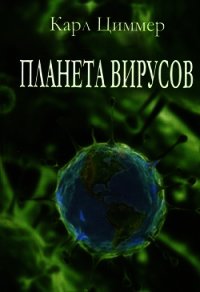Паразиты. Тайный мир - Циммер Карл (электронная книга txt) 📗
Caveney, S., Н. Mclean, and D. Surry. 1998. Faecal firing in a skipper caterpillar
is pressure-driven. Journal of Experimental Biology 201:121-133. Chan, M. S. 1997. The global burden of intestinal nematode infections — fifty
years on. Parasitology Today 13(11):438-443. Clayton, D. H. 1991. The influence of parasites on host sexual selection.
Parasitology Today 7(12):329-334. Collis, S. A., and G. Walker. 1994. The morphology of the naupilar stages of Sacculina carcini (Crustacea: Cirripedia: Rhizocephala). Acta Zoologica 75(4):297-303.
Costanza, R., B. G. Norton, and B. D. Haskell, eds. 1992. Ecological health: New
goals for environmental management. Washington, D.C.: Island Press. Cox, F. E. G. 1994. The evolutionary expansion of the sporozoa. International
Journal of Parasitology 24:1301-1316. Crompton, D. W. T. 1999. How much human helminthiasis is there in the world?
Journal of Parasitology 85:397-403. Curtis, L. A. 1987. Vertical distribution of an estuarine snail altered by a parasite. Nature 235:1509-1511.
. 1990. Parasitism and the movement of intertidal gastropod individuals.
Biological Bulletin 179:105-112. Damian, R. 1987. The exploitation of host immune responses by parasites.
Journal of Parasitology 73(1): 1-13. Damon, C. 1997. The mask of the parasite. Ann Arbor: University of Michigan Press.
Darwin, C. 1857. The origin of species. London: John Murray. Dawkins, R. 1982. The extended phenotype: The gene as the unit of selection. New York: W. H. Freeman.
. 1990. Parasites, desiderata lists and the paradox of the organism.
Parasitology 100:S63-S73. Day, J. F., and J. D. Edman. 1983. Malaria renders mice susceptible to mosquito feeding when gametocytes are most infective. Journal of Parasitology 69:163-170.
DeBerardinis, R. J., J. L. Goodier, E. M. Ostertag, and H. H. Kazazian. 1998. Rapid amplification of a retrotransposon subfamily is evolving the mouse genome. Nature Genetics 20:288-290. DeMoraes, С. M., W. J. Lewis, P. W. Pare, H. T. Alborn, and J. H. Tumlinson. 1998. Herbivore-infested plants selectively attract parasitoids. Nature 393:570-573.
Desmond, A., and J. Moore. 1991. Darwin: The life of a tormented evolutionist.
New York: W. W. Norton. Desowitz, R. S. 1983. New Guinea tapeworms and Jewish grandmothers. New York: W. W. Norton.
Desowitz, R.S. 1991, The malaria capers. New York: W. W. Norton.
. 1997. Who gave Pinta to the Santa Maria? New York:
W. W. Norton.
Despommier, D. D. 1990. Trichinella spiralis: The worm that would be virus. Parasitology Today 6(6): 193-196.
Despres, L., D. Imbert-Establet, C. Combes, and F. Bonhomme. 1992. Molecular evidence linking hominid evolution to recent radiation of schistosomes (Platyhelminthes: Trematoda). Molecular Phylogenetics and Evolution 1:295-304.
DeVries, M. C., D. Rittschof, and R. B. Forward. 1989. Response by rhizocephalan- parasitized crabs to analogues of crab larval-release pheromones. Journal of Crustacean Biology 9:517-524.
Dobson, A. 1995. The ecology and epidemiology of rinderpest virus in Serengeti and Ngorongoro conservation area. In Serengeti II: Dynamics, management, and conservation of an ecosystem, edited by A. R. E. Sinclair and P. Arcese. Chicago: University of Chicago Press.
Doolittle, W. F. 2000. Uprooting the tree of life. Scientific American 282: 90-95.
Drummond, H. 1883. Natural law in the spiritual world. London: Hod-der and Stoughton.
Dunbar, R. 1996. Grooming, gossip, and the evolution of language. Cambridge, Massachusetts: Harvard University Press.
Durden, L. A., and J. E. Keirans. 1996. Host-parasite coextinction and the plight of tick conservation. American Entomologist (Sum-mer): 87-91.
Dushay, M. S., and N. E. Beckage. 1993. Dose-dependent separation of Cotesia congregata — associated polydnavirus effects on Manduca sexta larval development and immunity. Journal of Insect Physiology 39(12): 1029- 1040.
Dybdahl, M. F., and С. M. Lively. 1998. Host-parasite coevolution: Evidence for rare advantage and time-lagged selection in a natural population. Evolution 52(8): 1057-1066.
Eberhard, W. G. 1990. Evolution in bacterial plasmids and levels of selection. Quarterly Review of Biology 65:3-22.
Ebert, D. 1994. Virulence and local adaptation of a horizontally transmitted parasite. Science 265:1084-1088.
, and E. A. Herre. 1996. The evolution of parasitic diseases. Parasitology Today 12(3):96-101.
Evans, W. S., M. C. Hardy, R. Singh, G. E. Moodie, and J. J. Cote. 1992. Effects of the rat tapeworm Hymenolepis diminuta on the co-prophagic activity of its intermediate host, 7Yibolium confusum. Canadian Journal of Zoology 70:2311-2314.
Evans, W.S. A. Wong, М. Hardy, R. W. Currie, and D. Vanderwel. 1998. Evidence that the factor used by the tapeworm, Hymenolepis diminuta, to direct the foraging of its intermediate host, Tribolium confusum, is a volatile attractant. Journal of Parasitology 84: 1098-1101.
Ewald, P. W. 1994. Evolution of infectious disease. Oxford: Oxford University Press.
. 1995. The evolution of virulence: A unifying link between parasitology and ecology. Journal of Parasitology 81 (5):659-669.
Farley, J. 1972. The spontaneous generation controversy (1700-1860): The origin of parasitic worms. Journal of the History of Biology 5(1):95-125.
. 1977. The spontaneous generation controversy from Descartes to Oparin.
Baltimore: Johns Hopkins University Press.
Feener, D. H., and В. V. Brown. 1997. Diptera as parasitoids. Annual Review of Entomology 42:73-97.
Foley, M., and L. Tilley. 1995. Home improvements: Malaria and the red blood cell. Parasitology Today ll(ll):436-439.
. 1998. Protein trafficking in malaria-infected erythrocytes. International Journal of Parasitology 28:1671-1680.
Foster, W. D. 1965. A history of parasitology. Edinburgh: E. & S. Livingstone.
Fox, J. A, M. F. Dybdahl, J. Jokela, and С. M. Lively. 1996. Genetic structure of coexisting sexual and clonal subpopulations in a freshwater snail (Potamopyrgus antipodarum). Evolution 50:1541-1548.
Friedman, M. J., and W. Trager. 1981. The biochemistry of resistance to malaria. Scientific American (March): 156-164.
Fuhrman, J. A. 1999. Marine viruses and their biogeochemical and ecological effects. Nature 399:541-548.
Gardner, S. L., and M. L. Campbell. 1992. Parasites as probes for biodiversity. Journal of Parasitology 78(4):596-600.
Gemmill, A. W., M. E. Viney, and A. F. Read. 1997. Host immune status determines sexuality in a parasitic nematode. Evolution 51(2):393-401.
Gilbert, J., E. Mouchel-Vielh, and J. S. Deutsch. 1997. Engrailed duplication events during the evolution of barnacles. Journal of Molecular Evolution 44:585-594.
Ginsburg, H., S. A. Wray, and P. G. Bray. 1999. An integrated model of chloroquine action. Parasitology Today 15:357-360.
Glenner, H., and J. T. Hoeg. 1995. A new motile, multicellular stage involved in host invasion by parasitic barnacles (Rhizocephala). Nature 377:147- 150.
, A. Klysner, and B. Brodin Larsen. 1989. Cypris ultrastructure,
metamorphosis and sex in seven families of parasitic barnacles
(Crustacea: Cirripedia: Rhizocephala). Acta Zoologica 23: 229-242.
Glenner, H., J. T. Hoeg, J. J. O'Brien, T. D. Sherman, 2000. Invasive vermigon stage in the parasitic barnacles Loxothylacus texanus and L. panopaei (Sacculinidae): closing of the rhizocephalan life-cycle. Marine Biology, in press.
Good, M. F., D. С Kaslow, and L. H. Miller. 1998. Pathways and strategies for developing a malaria blood-stage vaccine. Annual Review of Immunology 16:57-87.
Grenfell, В. T. 1992. Parasitism and the dynamics of ungulate grazing systems. The American Naturalist 139:907-929.
Gross, P. 1993. Insect behavioral and morphological defenses against parasitoids. Annual Review of Entomology 38:251-273.




